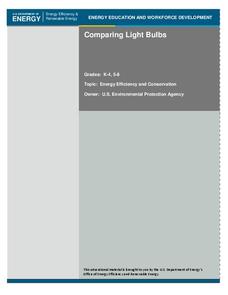Curated OER
Comparing Light Bulbs
An average home produces twice as many emissions as an average car. Teach your class how to reduce energy consumption by replacing standard incandescent light bulbs with compact fluorescent light bulbs. Perform an experiment to compare...
Perkins School for the Blind
What Would You Do If...?
What would you do if...? That's a great question, and, when posed to learners with visual impairments, a question that can foster concept development and speaking and problem-solving skills that relate to real-life situations. The...
Perkins School for the Blind
Silly or Sensible?
Is it silly or sensible? That's a great question, and it's the question that will drive this entire instructional activity. Learners with special needs and visual impairments work together to analyze verbal information. The instructor...
Baylor College
Gases Matter
As a demonstration or as a hands-on activity, your class watches as the combination of vinegar and baking soda produce carbon dioxide gas. The intent of the lesson is to help youngsters understand that gases occupy space. It is included...
Baylor College
Do Plants Need Light?
Turn your classroom into a greenhouse with a lesson on plant growth. First, investigate the different parts of seeds, identifying the seed coat, cotyledon, and embryo. Then plant the seeds and watch them grow! Measure the new plants...
Baylor College
Plant or Animal?
Teach your class about the necessities of life using the book Tillena Lou's Day in the Sun. After a teacher-read-aloud, students make puppets depicting different plants and animals from the story and illustrating the habitat in which...
Baylor College
Animals' Needs
Explore the wonderful world of earthworms as your class learns about the requirements of animal life. After building soda bottle terrariums, students observe worms over the course of a couple weeks, building an understanding that all...
Baylor College
Living Things and Their Needs: The Math Link
Enrich your study of living things with these cross-curricular math activities. Following along with the story Tillena Lou's Day in the Sun, learners will practice addition and subtraction, learn how to measure volume and length, work on...
Baylor College
Fungus Among Us
In order to learn that mold spores can be found in the air, observers grow bread mold and make observations for a few days. Afterward, they participate in a class discussion to arrive at the knowledge that bread spores are present in the...
Curated OER
Designing Clay
Maria and Juliana are two of the most famous Pueblo pottery makers of the modern era. The class will learn about pueblo pottery design and the ways that Maria and Julian use traditional designs in a new and innovative way. They will...
Curated OER
What’s in a Word?
A black raku tea bowl inspires a lesson on descriptive writing and the power of choosing words carefully to become stronger writers. The class inspects several images of a Japanese tea bowl, and then they use their imaginations to think...
Curated OER
Finding Meaning in the Badge
Children who are three to five years old study two rank badges from the Qing dynasty to develop an understanding of social rank, language skills, and symbolism. The instructional activity is discussion-based and requires learners to...
Curated OER
What Kind of Vessel Are You?
This is a strange question; but what kind of vessel would you be and why? After examining images of a large Inca jug, the class sets to writing a creative narrative that answers that very interesting question. They start by researching...
Curated OER
American Indian Art History Detectives
An art history detective; I want to be one of those! The class puts their heads together to hone their deductive and critical thinking skills in order to determine which Native American tribe created and used parfleche boxes. They'll use...
Curated OER
Majestic Murals
Albert Bierstadt is a highly celebrated artist who was able to capture the beauty of the American landscape. The class will first learn how Bierstadt explored America during the 1800s and painted the majestic countryside. Then, they will...
Curated OER
Celebration Scene
Art often captures an event or emotion from a specific time and place in history. Explore Painting of Bear and Sun Dances with your class to study how dance and celebrations were important aspects of Native American life. After...
Curated OER
Picture This
Give your littlest learners the opportunity to learn how to discuss, observe, and visualize. First, they determine if the image they are looking at is a photograph or a painting. Then they work together to brainstorm words that describe...
Curated OER
Contents and Containers
There is no better way to understand a different culture than to participate in its traditional or ceremonies. This lesson plan kicks off with a discussion about a tea container made during the Edo period in Japan. After examining the...
Curated OER
The Mysterious Present
Even history can be the basis for the inquiry process. First, several images of a bowls and vessels used in Japanese tea ceremonies are examined. Then, the class crafts questions about the origin, purpose, and use of the items. They use...
Baylor College
We Need Water
There's nothing quite like a glass of ice-cold, freshly squeezed lemonade. Lesson seven of this series explains how the water humans need to survive can come in many forms. Teach your class about how much water humans require every day...
Baylor College
Air and Breathing
Blow some bubbles and learn how living things need air in the eighth lesson of this series. Young scientists investigate this important gas by observing bubbles and monitoring their own breathing. A simple and fun activity that raises...
Baylor College
Needs of Living Things: Post-Assessment
Assess your class's knowledge of the needs of living things with the final lesson in a series. Given a large piece of paper and coloring utensils, young scientists draw a picture of themselves and a plant or animal of their choosing,...
Baylor College
A Place to Be
Home sweet home. Humans, birds, beavers, ants, we all need a place place to rest and keep us safe. In the ninth lesson of this series, the importance of shelter is discussed as the teacher reads aloud the book Tillena Lou's Day in the...
Baylor College
Need or Want?
Even as adults it can be hard to distinguish needs from wants. Using pictures of common, everyday items, children make a pocket chart separating the objects they need from those that they want. Discuss their choices, explaining that...

























